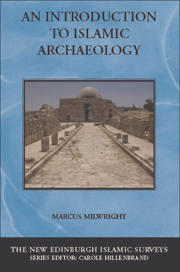Book contents
- Frontmatter
- Contents
- List of figures
- Acknowledgements
- Notes on transliteration and dating
- List of abbreviations
- 1 Introduction
- 2 Early Islam and late antiquity
- 3 New directions in the early Islamic period
- 4 The countryside
- 5 Towns, cities and palaces
- 6 Religious practice in the Islamic world
- 7 Crafts and industry
- 8 Travel and trade
- 9 The ‘post-medieval’ Islamic world
- 10 Conclusion
- Glossary
- Dynasties and periods
- Bibliography
- Index
3 - New directions in the early Islamic period
Published online by Cambridge University Press: 05 August 2013
- Frontmatter
- Contents
- List of figures
- Acknowledgements
- Notes on transliteration and dating
- List of abbreviations
- 1 Introduction
- 2 Early Islam and late antiquity
- 3 New directions in the early Islamic period
- 4 The countryside
- 5 Towns, cities and palaces
- 6 Religious practice in the Islamic world
- 7 Crafts and industry
- 8 Travel and trade
- 9 The ‘post-medieval’ Islamic world
- 10 Conclusion
- Glossary
- Dynasties and periods
- Bibliography
- Index
Summary
Artefacts such as bilingual papyri (Greek and Arabic) and ‘Arab-Sasanian’ coins provide persuasive evidence that the Arab elite relied heavily upon the pre-existing administrative practices and visual vocabulary of the newly conquered domains for most of the seventh century. The surviving epigraphic evidence shows how tentative the first employments of Muslim religious invocations and caliphal titulature were. Archaeology from regions such as Greater Syria indicates that the everyday lives of town and village dwellers experienced little radical change from the 630s to the end of the seventh century. Nevertheless, the Islamic conquests of the seventh and eighth centuries did represent a radical and irreversible break with the past that, over the course of decades and centuries, would transform the material culture of a vast area stretching from Spain to Central Asia. Changes can be detected in everything, from architecture, town planning, and portable artefacts to landscape, crops, and diet. Many of these issues will be revisited later in the book. This chapter will outline some of the key areas of interest by looking at the themes of synthesis, expansion, and innovation. The two case studies explore new aspects of the archaeological record of the eighth to the tenth century: first, the coin hoards of western Russia and Scandinavia; and, second, the two new building forms that transformed the early Islamic urban environment: the congregational mosque and the dar al-imara.
- Type
- Chapter
- Information
- An Introduction to Islamic Archaeology , pp. 44 - 58Publisher: Edinburgh University PressPrint publication year: 2010

